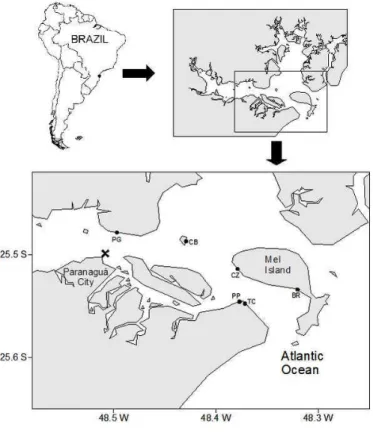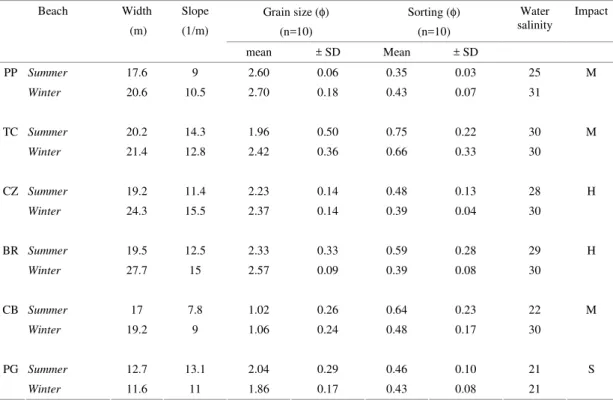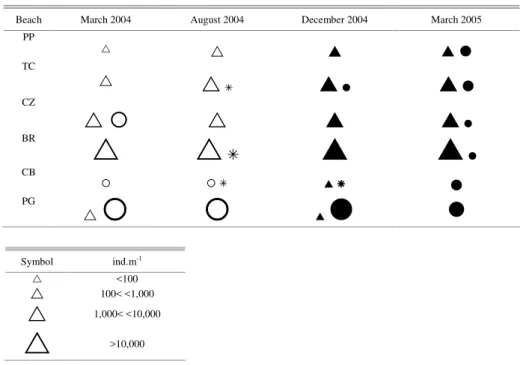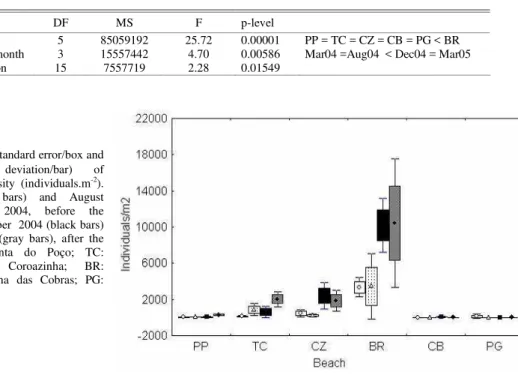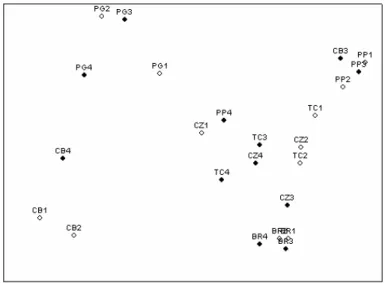IMPACT OF OIL SPILL AND POSTERIOR CLEAN-UP ACTIVITIES ON
WRACK-LIVING TALITRID AMPHIPODS ON ESTUARINE BEACHES
Carlos A. Borzone*and Leonardo C. Rosa
Universidade Federal do Paraná - Centro de Estudos do Mar (CEM) (Av. Beira Mar s/n, 83255-000 Pontal do Paraná, PR, Brasil)
*Corresponding author: capborza@ufpr.br
A
BSTRACTA geomorphological and faunistic seasonal study of six estuarine beaches on Paranaguá Bay, Brazil, was abruptly interrupted when the Chilean ship “Vicuña” exploded and sank, spilling 291 tons of bunker fuel oil. The beaches sampled twice before the accident were affected by the oil spill deposition and the posterior clean-up activities. Neither drastic reduction in abundances nor occurrences of oil-covered individuals were registered. Significant variation in both amount of debris and talitrid amphipod densities was directly related to beach clean-up activities. A short (1–3 month) manual clean-up of polluted wrack resulted in an increase in talitrid abundances, with the local distribution expansion of one species, Platorchestia monodi, from three to six of the beaches sampled. The active migration and concentration of organisms at sites without wrack during cleaning activities and a massive and continuous recovery of new debris, characteristic of estuarine beaches, may contribute to the findings.
R
ESUMOUm estudo sazonal da geomorfologia e fauna de seis praias estuarinas na baia de Paranaguá, Brasil, foi interrompido bruscamente pela explosão e posterior afundamento do navio chileno Vicuña, que derramou 291 toneladas de óleo bunker. As praias que foram afetadas pela deposição de óleo e pelas posteriores atividades de limpeza, tinham sido amostradas duas vezes antes do acidente. Nas coletas posteriores ao acidente não foram registradas nem reduções drásticas das abundâncias nem indivíduos impregnados por óleo. As significativas variações tanto da quantidade de detrito quanto nas densidades de anfipodes talitrídeos foram relacionadas às atividades de limpeza. Uma limpeza manual e de curta duração (1 a 3 meses) resultou num aumento das abundâncias dos talitrídeos, juntamente com o aumento da distribuição de uma das espécies, Platorchestia monodi, que de três passou a ser encontrada em seis praias amostradas. Os fatores que contribuíram para estes resultados foram, por um lado, a migração ativa e a concentração de organismos em locais sem detrito durante as atividades de limpeza, e por outro, o contínuo aporte de novo detrito característico das praias estuarinas.
Descriptors: Oil spill, Estuarine beach, Talitrid amphipods, Wrack clean-up. Descritores: Derrame de óleo, Praia estuarina, Anfipode talitrideo, Limpeza de detrito.
I
NTRODUCTIONParanaguá Bay is an estuary of the southern Brazilian coastal ecosystem that supports an intense volume of international merchant shipping. On the estuarine shoreline, mangroves, marsh, and sandy beaches are well developed. Estuarine beaches are very common near the inlets and also up the estuary, where small fishing villages are usually established in their proximity (BORZONE et al., 2003; ROSA; BORZONE, 2008). These beaches receive a great contribution of mangrove and marsh macrodetritus, cast ashore by waves and tides, and in some cases macroalgae from subtidal flat environments. Thus, a
conspicuous beach wrack develops on the upper beach face in the form of one or more accumulations known as drift lines (ROSA et al., 2007).
Many studies describe the ecological importance of beach wrack as a basic element of food webs through which energy is transformed from one component into another (MCLACHLAN; BROWN, 2006). Wracks are particularly important on exposed beaches where they stabilize the foreshore by enhancing the organic and moisture contents, allowing pioneer plants to become established (LLEWELLYN; SHACKLEY, 1996; GHESKIERE, et al., 2006).
CHELAZZI, 2003), broken branches with fruit, seeds, and mangrove leaves may be more important in estuarine ecosystems. It has been shown that, in general, these allochthonous subsidies have beneficial effects on different communities, increasing species richness and population densities. Apart from providing food, the most obvious physical effect of wrack deposits is to provide shelter and a suitable microhabitat for a number of different taxonomic groups of animals (LAVOIE, 1985; COLOMBINI et al., 2000). Large stranded driftwood becomes an important habitat for many beach arthropods, especially amphipods of the family Talitridae, which are considered to be the primary colonizers of newly deposited wracks because of their tendency to forage on freshly stranded material (BEHBEHANI; CROKER, 1982; MARSDEN, 1991; COLOMBINI et al., 2000; ROSA et al., 2007).
On the other hand, the effect of hydrocarbon contamination on beaches is especially harmful to the upper tidal zones, where wrack accumulates and where these amphipods live. This group of crustaceans lacks a larval phase for dispersion; hence, females transport embryos until they become individuals morphologically similar to the adults. Thus, when a population is removed or killed, as in the case of a contaminant spillage, its recovery depends on recruits coming from other more or less neighboring populations. For these reasons, the upper levels of beaches present extreme sensitivity to human disturbance (DE LA HUZ et al., 2005).
Knowledge of the impact of contaminants on the estuarine beach environment is sparse. Estuarine beaches may be considered a transitional environment between beaches open to the ocean, which are usually wave dominated, and their corresponding tide-dominated environments, the tidal flats (MASSELINK; SHORT, 1993; BORZONE et al., 2003); few ecological studies have been carried out on estuarine environments despite the constant presence of contaminants (NORDSTROM, 1992).
A geomorphological and faunistic seasonal study of these particular beach environments on Paranaguá Bay began in January 2004, but was abruptly interrupted by an accident on November 15 when the Chilean ship named “Vicuña” exploded and sank, spilling 291 tons of bunker fuel oil (≅ 88% Nr. 2 fuel oil and 12% medium fuel oil 180) in Paranaguá Port (25º30’S; 48º32’W). Most of the beaches sampled
were affected by the oil spill deposition and the posterior cleaning activities. This accident represented a unique opportunity to undertake a study with a before/after design, a condition useful for environmental impact assessment (OSENBERG; SCHMITT, 1996).
The objective of the present contribution was to assess the possible influence of oil spill
contamination and its posterior beach-cleaning procedures on the structure of talitrid assemblages on sandy estuarine beaches.
M
ATERIAL ANDM
ETHODSInside the estuary, the increase in astronomical tidal range by morphological embayment and the action of small and short-period waves originated by local winds and wakes results in estuarine beaches with highly similar morphology (BORZONE et al. 2003, ROSA; BORZONE, 2008). Six of these beaches, namely, Brasilia, Coroazinha, Ponta do Poço, Techint, Ilha das Cobras, and Piaçaguera, were selected for this study (Fig. 1). The estuarine beach profile consists of a narrow (11.6-27.7 meter), steep (1/7.8-1/15.5 meter) upper reflective beach (Table 1). A clear discontinuity in the profile with a distinct break of slope and a localized groundwater outcrop separates this upper beach from a sandy or muddy tidal flat, variable in width but generally very gentle (1/50 to 1/300 meters) in slope. Only one of the six beaches studied (Ponta do Poço) does not follow this morphological pattern, probably because the proximity of a tidal channel inhibits the formation of a tidal flat (ROSA; BORZONE, 2008). Sediment grain size in the upper beach environment varied from fine to coarse sand (2.7 to 1 φ), with two beaches (Piaçaguera and Techint) varying from fine to medium sand between seasons. Well-sorted sand was common on all the beaches, only one having moderately sorted sand (Techint). As expected, water salinity presented a reduction upward along the estuary, with the lowest values at the Piaçaguera beach.
Samples were taken in March and August 2004, before the accident, and December 2004 and March 2005, 30 and 120 days after the accident, respectively. Three drift lines were found and sampled at each beach, except in December 2004 when only one drift line was recognized owing to the intensive cleaning activities that were implemented soon after the accident. At each beach, three samples were taken by pressing a steel core (≅ 0.05 m2) covered at one
(summer and winter) before the accident. The extent to which the beaches studied were contaminated was unknown. However, data from reports of the accident on the number of days and persons working on grooming activities were used as an index of the human impact caused by the cleaning and fuel removal carried out on the beaches studied. The clean-up operations consisted of the daily manual removal of all drift macrodetritus (with or without oil contamination) and manual (hackle and shovel) removal of patches of oil from the beaches´ surface. Three categories of human impact were used: small impact, in which the activities of two cleaners were extended for two weeks after the accident; medium impact, with up to five cleaners working until December 2004; and high impact, with more than five cleaners working until February 2005 (Table 1). No cleaning activities were registered after March 2005, except on the Ilha das Cobras beach. Here, soldiers continually removed drift
detrital materials because the Brazilian Army maintains a weekend residence of the State Governor. Two-way factorial ANOVA was performed for detrital weight and talitrid species’ densities using beaches (n=6) and sample day (n=4) as factors, and a Schefee test was performed for a post-hoc comparison of means. Only data from the fresh drift line were transformed into m2 and used in these analyses (three
samples). Multidimensional scaling analyses (MDS) were also conducted using a Bray Curtis dissimilarity matrix (CLARK; WARWICK, 1994), considering the square root of the total linear abundance of the three species of talitrid amphipods for each beach and sample day. Data of abundances obtained from all the drift lines sampled and expressed as linear abundances, that is, the square meter density per strip transect (ANSELL et al., 1972; BRAZEIRO; DEFEO, 1996) were used in this analysis.
Table 1. Physical characteristics of upper beaches sampled in March (summer) and August (winter) 2004, before the accident, and index of impact estimated after the accident. Granulometric values (grain size and sorting) are means of ten samples distributed along the entire profile. PP: Ponta do Poço; TC: Techin; CZ: Coroazinha; BR: Brasilia; CB: Ilha das Cobras; PG: Piaçaguera; M: medium impact; H:high impact; S: small impact.
Grain size (φ) (n=10)
Sorting (φ) (n=10)
Water salinity
Impact
Beach Width
(m)
Slope (1/m)
mean ± SD Mean ± SD
PP Summer 17.6 9 2.60 0.06 0.35 0.03 25
Winter 20.6 10.5 2.70 0.18 0.43 0.07 31
M
TC Summer 20.2 14.3 1.96 0.50 0.75 0.22 30
Winter 21.4 12.8 2.42 0.36 0.66 0.33 30
M
CZ Summer 19.2 11.4 2.23 0.14 0.48 0.13 28
Winter 24.3 15.5 2.37 0.14 0.39 0.04 30
H
BR Summer 19.5 12.5 2.33 0.33 0.59 0.28 29
Winter 27.7 15 2.57 0.09 0.39 0.08 30
H
CB Summer 17 7.8 1.02 0.26 0.64 0.23 22
Winter 19.2 9 1.06 0.24 0.48 0.17 30
M
PG Summer 12.7 13.1 2.04 0.29 0.46 0.10 21
Winter 11.6 11 1.86 0.17 0.43 0.08 21
S
R
ESULTSA great contribution of mangrove and marsh macrodetritus, and in only one case macroalgae from a tidal flat environment (Acanthophora spicifera on Brasilia beach), together with an irregular and semidiurnal tidal pattern determined a conspicuous development of up to three drift lines. Three species of talitrid amphipods were collected during this study: Platorchestia monodi, Talorchestia tucurauna, and Atlantorchestoidea brasiliensis. Of these, P. monodi represented 51% of the total number of individuals, while T. tucurauna and A. brasiliensis represented 48 and 1%, respectively. The greatest abundance of P. monodi was found on the Piaçaguera beach. Before the accident, this species had occurred on three beaches, but occurred on all the beaches sampled (Table 2) four months later. T. tucurauna had its greatest abundance on Brasilia Beach, and occurred at five of the six beaches sampled. One month after the accident, it had spread to all the beaches, but four months later remained on the four beaches with the highest salinity values. A. brasiliensis presented an erratic occurrence with low abundance on three beaches before the accident but disappeared four months later (Table 2).
Macrodetrital dry weight showed significant differences between beaches and samples (Table 3). Techint beach received a greater contribution of debris, with a maximum value of 5 kg. m-2 (March
2004) followed by Piaçaguera and Ponta do Poço beaches. The smaller deposition on the Cobras beach throughout the study period resulted from a continuous clean up of drifts for esthetic purposes. As expected, a clear reduction in the debris was detected one month after the accident as a direct consequence of the cleaning activities, but a high deposition was registered again four months later, when cleaning activities were definitively suspended and similar quantities of debris were registered as one year before (Fig. 2).
Table 2. Occurrence (individuals.m-1 ) of the three species of talitrid amphipod collected on each beach before (March and August 2004, white symbols) and after (December 2004 and March 2005, black symbols) the accident. Names of the beaches as in Table 1. Talorchestia tucurauna ( ), Platorchestia monodi ( )and Atlantorchestoidea brasiliensis ( ).PP: Ponta do Poço; TC: Techint; CZ: Coroazinha; BR: Brasilia; CB: Ilha das Cobras; PG: Piaçaguera.
Beach March 2004 August 2004 December 2004 March 2005
PP
TC
CZ
BR
CB
PG
Table 3. Summary of two-way factorial ANOVA performed for macrodetritus (dry weight.m-2). PP: Ponta do Poço; TC: Techint; CZ: Coroazinha; BR: Brasilia; CB: Ilha das Cobras; PG: Piaçaguera.
DF MS F p-level Sheffe PosHoc
Beach 5 5.17 11.11 0.00001 BR = CB = CZ < PG = PP < TC Sample month 3 5.05 10.86 0.00015 Dec04 < Aug04 < Mar04 = Mar05
Interaction 15 3.55 7.62 0.00001
Fig. 2. Mean (± standard deviation) of macrodetrital dry weight.m-2. March (white columns) and August (dashed columns) 2004, before the accident; December 2004 (black columns) and March 2005 (gray columns), after the accident. PP: Ponta do Poço; TC: Techint; CZ: Coroazinha; BR: Brasilia; CB: Ilha das Cobras; PG: Piaçaguera.
Symbol ind.m-1
<100 100< <1,000 1,000< <10,000
Table 4. Summary of two-way factorial ANOVA performed for T.tucurauna density (individuals.m-2). PP: Ponta do Poço; TC: Techint; CZ: Coroazinha; BR: Brasilia; CB: Ilha das Cobras; PG: Piaçaguera.
DF MS F p-level
Beach 5 85059192 25.72 0.00001 PP = TC = CZ = CB = PG < BR Sample month 3 15557442 4.70 0.00586 Mar04 =Aug04 < Dec04 = Mar05 Interaction 15 7557719 2.28 0.01549
Table 5. Summary of two-way factorial ANOVA performed for P. monodi density (individuals.m-2). PP: Ponta do Poço; TC: Techint; CZ: Coroazinha; BR: Brasilia; CB: Ilha das Cobras; PG: Piaçaguera.
DF MS F p-level
Beach 5 235709232 246.49 0.00001 PP = TC = CZ = CB = BR < PG Sample month 3 98557816 103.07 0.00001 Mar04 = Mar05 < Aug04 < Dec04 Interaction 15 103523744 108.26 0.00001
Fig. 3. Mean (± standard error/box and
± standard deviation/bar) of T.tucurauna density (individuals.m-2). March (white bars) and August (dashed bars) 2004, before the accident; December 2004 (black bars) and March 2005(gray bars), after the accident.PP: Ponta do Poço; TC: Techint; CZ: Coroazinha; BR: Brasilia; CB: Ilha das Cobras; PG: Piaçaguera.
MDS ordination (Fig. 5) showed that the Piaçaguera and Brasilia beaches maintained their characteristic talitrid composition in spite of the disturbance. The first beach, with small impact, was characterized by the dominances of
P. monodi, and the second, with high impact, by
the dominances of T.tucurauna. Cobras beach,
with the smallest abundances of P. monodi,
forms a distinct group of samples, with one exceptional sample where this species was replaced by T. tucurauna. The other beaches,
with medium to high impact, showed a clear alteration of their talitrid composition after the accident because of the expansion of P. monodi
distribution on those beaches.
D
ISCUSSIONThe family Talitridae represents the only amphipod group that colonizes the terrestrial environment (BOUSFIELD, 1984). Four species of talitrid amphipods with a wide distribution (from 6– 10° to 23–28° S) are present along the Brazilian coast (SEREJO, 2004) and three of them appeared on Paranaguá Bay (ROSA et al., 2007). P. monodi prefer protected beaches and can be found in estuarine areas and mangrove swamps while T. tucurauna often inhabit the supralittoral zone of exposed sandy beaches and are found together with A. brasiliensis (SEREJO, 2004). The samples collected on Paranaguá Bay before the accident reflected this preference, with P. monodi present on most internal and protected beaches.
After the Vicuña accident, statistically significant variation in the quantities of debris and talitrid amphipod densities pointed to the impact of the oil spill and the cleaning activities. Because sediment is a pollution trap, the sandy beach community may in fact experience the effects of pollution and show a much higher initial mortality (MCLACHLAN; BROWN, 2006). Macrofaunal responses to oil spills are highly variable. Gomez-Gesteira and Dauvin (2000) observed that species sensitive to hydrocarbons, especially crustaceans and more specifically amphipods, disappear rapidly and show very high initial mortalities. In the present study, neither drastic reduction in talitrid abundances nor occurrences of oil-covered individuals were registered. For this reason, we may infer that most of the differences registered were directly related to debris clean-up activities.
Frequently used beaches are often cleaned to make them attractive to tourists. Cleaning takes several forms ranging from simple litter picking to mechanized operations that remove all natural strandlines, as well as the garbage, and usually grade the sand (DAVENPORT; DAVENPORT, 2005). Gheskiere et al. (2005) have demonstrated that the upper zone of the Mediterranean and Baltic sandy beaches used by tourists have lower concentrations of organic matter, and lower densities and diversities of invertebrates than neighboring non-tourist beaches. This appeared to result from combinations of beach cleaning, trampling, and disturbance. Cobras beach represented a clear example of impact related to a continuous removal of wrack, and the accident studied did not produce great changes in its impoverished talitrid assemblage.
The Prestige accident, a 60,000-ton oil spill that affected 300 km of the Galician Coast, showed that the supratidal beach zone was greatly affected, resulting in the practical disappearance of insects and a clear reduction in the numbers of the talitrid amphipods and the semiterrestrial isopod Tylos (DE LA HUZ et al., 2005). In this case, the cleaning of
stranded algal wrack after the spill affected the infauna negatively and either directly because of the physical removal of macrofauna or indirectly because of the removal of food and refuge. For these reasons, talitrid amphipods and the semiterrestrial isopod Tylos showed a clear reduction in numbers (JUNOY et al., 2005).
Should the beach be cleaned or not after a spill disaster? That is an often-repeated question. Peterson (2001) showed that affected beaches that were cleaned took longer to recover than those not cleaned in the case of the Exxon Valdez oil spill. Whitfield (2003) affirmed that every intensive clean-up option has its drawbacks; for example, the high-pressure hot water on the Alaskan shoreline fouled by the Exxon Valdez spill in 1989. Chemical cleaners also cause damage, for example in Cornwall, UK, in 1967, where oiled beaches were sprayed with 10,000 tons of powerful solvents and detergents, which caused the death of many seashore invertebrates (WHITFIELD, 2003).
On the other hand, the present study shows that in the Vicuña case, a temporally short (1–3 month) and manual clean-up of the polluted wrack resulted in an increase of some talitrid abundances, with an expansion of their local distribution. Two factors may have contributed to this finding: one is that talitrid amphipods are generally considered to be primary colonizers of newly stranded wrack (INGLIS, 1989; COLOMBINI et al., 2000; JEDRZEJCZAK, 2002) and the other is that estuarine beaches are characterized by a massive and continuous recovery of new debris (Nordstrom, 1992) and, in the present case, free of oil. The active migration and concentration of organisms to locals without wrack, as dunes or vegetated backshore, during clean-up activities, may contribute to the maintenance and posterior increase in the talitrid population. Furthermore, talitrid amphipods can also be dispersed together with the wrack (PERSSON, 2001; ROSA et al., 2007). This dispersion mechanism could facilitate the colonization of “newly created” habitats by individuals from unaffected areas and may thus explain the observed expansion of the distribution of P. monodi after disturbance.
Even thought deeper or repeated cleaning activities will certainly result in much slower recolonization rates, manual cleaning activities are
strongly recommended in the case of estuarine beach ecosystems.
R
EFERENCESANSELL, A. D.; SIVADAS, P.; NARAYANAN, B.; SANKARANARAYANAN, V. N.; TREVALION, A. The ecology of two sandy beaches in southwest India. I. Seasonal changes in physical and chemical factors, and in the macrofauna. Mar. Biol., v. 17, p. 38-62, 1972.
BEHBEHANI, M. I.; CROKER, R. A. Ecology of beach wrack in northern New England with special reference to Orchestia platensis. Estuar. coast. Shelf Sci., v. 15, p. 611–620, 1982.
BORZONE, C. A.; MELO, S. G.; REZENDE, K. V.; VALE, R.; KRUL, R. Macrobenthic intertidal communities from wave to tide dominated beaches environment: a case of two Brazilian beaches. J. coast. Res., v. SI 35, p. 472-480,2003.
BOUSFIELD, E. L. Recent advances in the systematics and biogeography of landhoopers (Amphipoda: Talitridae) of the Indo-Pacific region. In: RADOVSKY, F. J.; RAVEN, P. H.; SOHMER, S. H. (Ed.). Biogeography of the tropical Pacific. Bishop Mus. spec. Publ., v. 72, p. 171-210, 1984.
BRAZEIRO, A.; DEFEO, O. Macroinfauna zonation in microtidal sandy beaches: is it possible to identify patterns in such variable environments? Estuar. coast. Shelf Sci., v. 42, p. 523-536, 1996.
CLARK, K. B.; WARWICK, R.M. Change in marine communities: an approach to statistical analysis and interpretation. Natural Environment Research Council, UF. Bournemouth, UK: Bourne Press Limited, 1994. 144 p.
COLOMBINI, I.; CHELAZZI, L. Influence of marine allochthonous input on sandy beach communities.
Oceanogr. mar. Biol. a. Rev., v. 41, p. 115–159, 2003. COLOMBINI, I.; ALOIA, A.; FALLACI, M.; PEZZOLI, G.;
CHELAZZI, L. Temporal and spatial use of stranded wrack by the macrofauna of a tropical sandy beach. Mar. Biol., v. 136, p. 531–541, 2000.
DAVENPORT, J.; DAVENPORT, J.L. The impact of tourism and personal leisure transport on coastal environments: A review. Estuar. coast. Shelf Sci., v. 67, p. 280-292, 2006.
DE LA HUZ, R.; LASTRA, M.; JUNOY, J.; CASTELLANOS, C.; VIEITEZ, J.M. Biological impacts of oil pollution and cleaning in the intertidal zone of exposed sandy beaches: Preliminary study of the ‘‘Prestige’’ oil spill. Estuar. coast. Shelf Sci., v. 65, p.
19-29, 2005.
GHESKIERE, T.; VINCX, M.; PISON, G.; DEGRAER, S. Are strandline meiofaunal assemblages affected by a once-only mechanical beach cleaning? Experimental findings. Mar. environ. Res., v. 61, p. 245–264, 2006.
GÓMEZ-GESTEIRA, J.L.; DAUVIN, J.C. Amphipods are good bioindicators of the impact of oil spills on soft-bottom macrobenthic communities. Mar. Pollut. Bull., v. 40, p. 1017-1027, 2000.
JEDRZEJCZAK, M. F. Spatio-temporal decay ‘hot spots’ of stranded wrack in a Baltic sandy coastal system. Part I. Comparative study of the pattern: 1 type of wrack vs 3 beach sites. Oceanologia, v. 44, p. 491–512, 2002. JUNOY, J.; CASTELLANOS, C.; VIEITEZ, J. M.; DE LA
HUZ, R.; LASTRA, M. The macroinfauna of the Galician sandy beaches (NW Spain) affected by the Prestige oil-spill. Mar. Pollut. Bull. , v. 50, p. 526–536,
2005.
LAVOIE, D. Population dynamics and ecology of beach wrack macroinvertebrates of the central California coast.
Bull. south. Calif. Acad. Sci., v. 84, p. 1–22, 1985.
LLEWELLYN P.J.; SHACKLEY S.E. The effects of mechanical beach-cleaning on invertebrate populations.
Br. Wildl. , v. 7, p. 147–155, 1996.
MCLACHLAN, A.; BROWN, A.C. The ecology of sandy shores. Elsevier, USA, 2006.
MARSDEN, I. D. Kelp-sandhopper interactions on a sand beach in New Zealand. II. Population dynamics of Talorchestia quoyana (Milne-Edwards). J. expl. mar.
Biol. Ecol., v. 152, p.75–90, 1991.
MASSELINK, G.; SHORT, A. D. The effects of tide range on beach morphodynamics and morphology: a conceptual beach model. J. coast. Res., v.9, p. 785-800, 1993.
NORDSTROM, K.F. Estuarine beaches: an introduction to the physical and human factors affecting use and management of beaches in estuaries, lagoons, bays and fjords. London: Elsevier Applied Science, 1992.
.
OSERNBERG, C. W.; SCHMITT, R. J. Detecting ecological impacts caused by human activities. In: SCHMITT, R. J.; OSENBERG, C. W. Detecting ecological impacts. Concepts and applications in coastal habitats. New York: Academic Press, 1996. p. 9-15.
PERSSON, L.-E. Dispersal of Platorchestia platensis (Kröyer) (Amphipoda: Talitridae) along Swedish coasts: a slow but successful process. Estuar. coast. Shelf Sci.,
v. 52, p. 201-210, 2001.
PETERSON, C.H. The Exxon Valdez oil spill in Alaska: acute indirect and chronic effects on the ecosystem. Adv. mar. Biol., v. 39, p. 1-103, 2001.
ROSA, L.C.; BORZONE, C.A. Uma abordagem morfodinâmica na caracterização física das praias estuarinas da baia de Paranaguá, sul do Brasil. Revta Bras. Geociênc., v. 38, n. 2, p. 237-245, 2008. ROSA, L. C.; ALUIZIO, R.; BORZONE, C.A. Talitridae
(Amphipoda, Crustacea) das praias estuarinas da Baía de Paranaguá, Paraná, Brasil. Braz. J. aquat. Sci. Technol., v. 11, p. 37-41, 2007.
SEREJO, C.S. Talitridae (Amphipoda, Gammaridea) from the Brazilian coastline. Zootaxa, v. 646, p. 1-29, 2004.
WHITFIELD, J. How to clean a beach. Nature, v. 422, p.
464-466, 2003.
